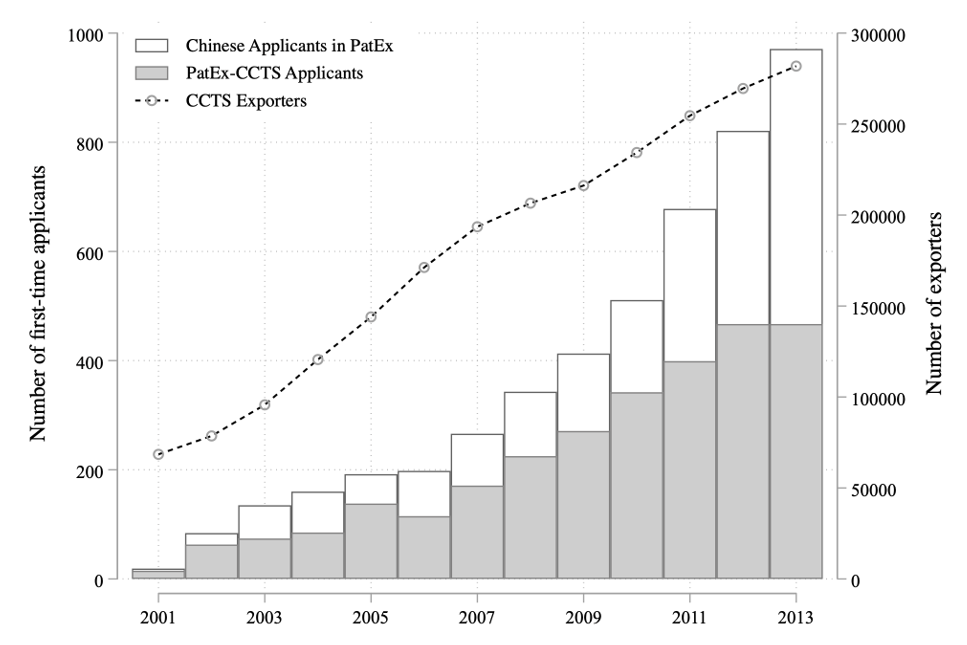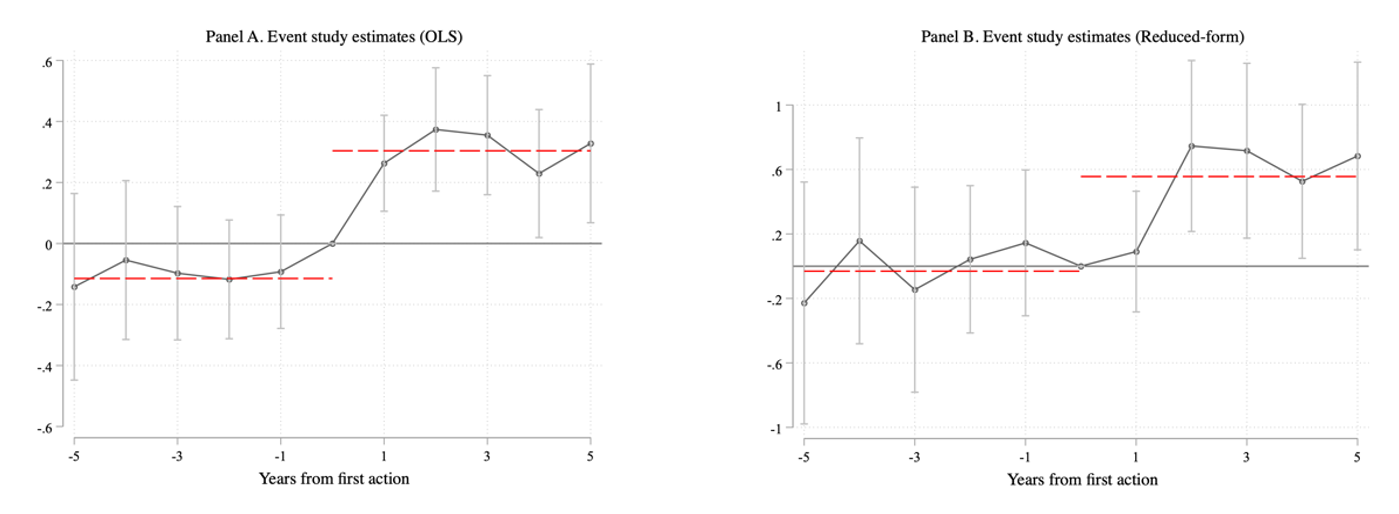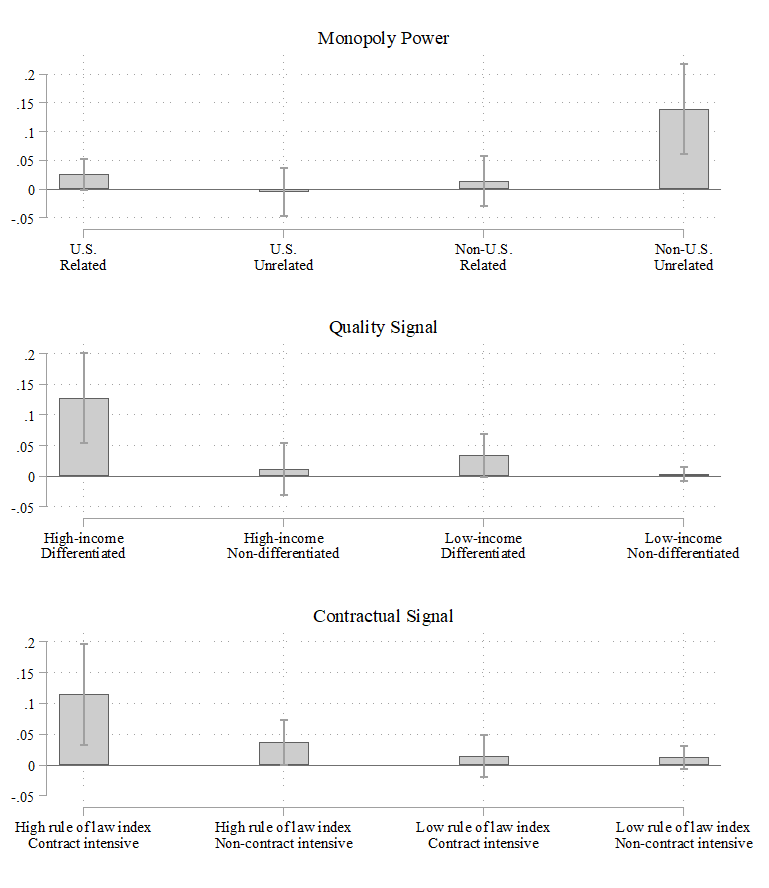
Patents from recognised hubs confer benefits to foreign patent holders beyond market protection, such as valuable global signals of quality and credibility
Global patenting and trade
Global patent activity has been steadily increasing over the past few decades. For instance, more than half of all patent applications received by the US Patent and Trademark Office (USPTO) are now from foreign countries, with many of them coming from emerging economies. These trends raise some critical policy questions: why do firms patent their innovations abroad? What challenges do firms from emerging economies with weak intellectual property rights (IPR) face in the global marketplace? Can established patent authorities in developed countries act as global hubs to alleviate these challenges?
The previous trade literature has established that innovation (and consequently productivity improvement) is closely related to firms’ export activities (Melitz 2003, Aw et al. 2008, Aw et al. 2011). Recent work also finds that the strength of a destination’s IPR enforcement may affect its export appeal (Palangkaraya et al. 2017). However, few studies have investigated how cross-border patenting, conditional on firms’ innovation prowess, affect firms’ export performance. Examining these questions can reveal not only important lessons for international trade, but also inform the mechanisms that underlie patent activity and its economic outcomes more generally.
Chinese firms applying for US patents
Figure 1: Chinese trade and USPTO patent activity over time

In recent work (Gong et al. 2023), we identify the causal impact of US patent grants on Chinese firms’ exports. We manually match over 1,800 exporters in China’s customs data to USPTO’s patent application records. We observe a remarkable surge of first-time Chinese applicants applying for US patents during 2001 to 2013 (Figure 1) - the number of first-time applicants rose from single digits in 2001 to nearly 1,000 in 2013, with about half of them engaging in exporting. Chinese exporters filing for a US patent are on average bigger, more productive, more technologically advanced, and more successful in foreign markets. Moreover, anecdotal evidence suggests that US patents play a crucial role when these applicants compete in foreign markets. Several firms in our data prominently displayed their respective award of a US patent in media outlets or company websites as indicators of success in the global market.
Export outcomes between successful and unsuccessful patent applicants are not comparable outcomes for disentangling the effect of patent grant on exports, as they are fundamentally different types of applicants – more successful applicants are probably going to be better at exporting anyway, for example. To address this issue, we exploit the quasi-random assignment of patent applications to examiners to disentangle the causal impact of a US patent grant on firm exports. Under the USPTO’s patent examination system, while each patent application is assigned to an art unit based on its specific technology class, the allocation of patents to examiners within an art unit has been described as close to a random lottery draw (Lemley and Sampat 2012, Sampat and Williams 2019). In addition, there is systematic variation in each examiner’s propensity to approve applications. This variation in the ex-ante expected patent approval rate of a quasi-randomly assigned examiner helps us identify comparable firms who happened to be granted (or not granted) a patent, solely based on assigned examiner (Farre-Mensa et al. 2020).
US patents: Tickets to the global market
Our main finding suggests that a US patent serves as a ‘ticket’ to the global market for Chinese exporters, as successful first-time patent applicants achieve significantly higher export growth compared to otherwise similar first-time applicants that failed. A first-time US patent grant improves the applicant’s annualised export growth by 17.5% in the subsequent three years after the first action of the patent examiner. A flexible event study analysis (Figure 2) further reveals that the effect of a patent grant materialises quickly and remains relatively stable five years out.
A patent award triggers an expansion along both the extensive and intensive margins of exports. Around 87.4% of the overall patent-induced effect on export growth is driven by increased sales to firms’ already existing foreign markets, while expansion into new markets accounts for the remaining 12.6%. We also see that a successful first patent application raises firms’ survival probability in existing foreign markets and increases export quantities and sales in the surviving markets.
Figure 2: Event study around the time of the first-time patent grant

What roles do US patents play?
Why should a US patent grant benefit Chinese firms’ export growth? Given our identification strategy, this effect cannot be simply attributed to firm innovation improving export outcomes, since we compare the differential trade performance of highly innovative patent filers, of which only some received a patent award. We posit two possible mechanisms: monopoly power and patent signal.
Figure 3: Decomposition and Mechanisms

Monopoly power
A patent, in the first place, grants the holder exclusive rights to use the underlying technology or invention for a specific period. Thus, a natural conjecture is that a US patent grant strengthens the Chinese applicant’s monopoly power and sales of products under patent protection specifically in the US market. However, since a US patent entails legal recognition only in the US, the monopoly power mechanism implies that the patent effect should be confined to the exports of products directly covered by the patent and sold to the US.
Surprisingly, we find that while exports to the US of products technologically related to the first patent grant (Goldschlag et al. 2020) grow significantly after the patent grant, this contributes only 15% of the overall patent-induced export growth (Figure 3 Panel A). Instead, we find that 79% of the patent effect is driven by an increase in exports of unrelated products to non-US markets. We also observe that Chinese exporters do not differentially revise the pricing or sales of technologically related products in the US market. In sum, while we find some evidence for the monopoly power mechanism, the data indicates that some other mechanism must be at play and first-order.
Patent signal
One possibility is that receiving a US patent constitutes a signal that can alleviate the overall information frictions that a firm faces in the global market. Different forms of information frictions can manifest in different ways. Two dimensions that the prior literature has identified as important in cross-border firm-to-firm relationships is product quality and contract enforcement.
We provide evidence consistent with a US patent sending a signal about two desirable attributes of a Chinese firm: the capacity to deliver high-quality products and the credibility to carry out contractual obligations. Over 70% of the overall patent-induced export growth of patent recipients is driven by quality-sensitive goods (Rauch 1999) to high-income markets that have greater demand and willingness to pay for quality (Figure 3 Panel B). A first US patent grant improves a Chinese firm’s export survival probability of quality-sensitive products disproportionately more for high-income markets.
We likewise find revealing patterns for the contractual signal hypothesis. The patent effect on trade performance is mainly concentrated in contract-reliant industries (Nunn 2007, Levchenko 2007) and destinations with a strong contract environment that demand such inputs in production (Figure 3 Panel C). The survival probability of exports in contract-reliant industries is also disproportionately higher for destinations with better contract enforcement.
Policy takeaways: Benefits of global patent hubs
Our findings suggest that global patent hubs, such as the USPTO, the European Patent Office (EPO), and the Japan Patent Office (JPO), may confer benefits to foreign patent holders that extend beyond market protection in their own jurisdictions. Firms from emerging economies can signal their quality capacity and contract credibility and overcome trade barriers due to information frictions by obtaining patent recognition from such global patent hubs.
These results have various important policy implications. Emerging economies seeking to promote trade, especially with profitable developed markets, may find it advantageous to strengthen collaboration with countries with well-established IPR institutions. Improving the quality of home institutions can also enable domestic patent grants to act as valid signals in the global market. From a global perspective, patent hubs may be welfare-enhancing to the extent that they alleviate market frictions arising from information asymmetry and support global growth through worldwide innovation.
References
Aw, B Y, M J Roberts, and D Y Xu (2008), "R&D investments, exporting, and the evolution of firm productivity", American Economic Review 98(2): 451-456.
Aw, B Y, M J Roberts, and D Y Xu (2011), "R&D investment, exporting, and productivity dynamics", American Economic Review 101(4): 1312-1344.
Farre‐Mensa, J, D Hegde, and A Ljungqvist (2020), "What is a patent worth? Evidence from the US patent lottery”, The Journal of Finance 75(2): 639-682.
Goldschlag, N, T J Lybbert, and N J Zolas (2020), "Tracking the technological composition of industries with algorithmic patent concordances", Economics of Innovation and New Technology 29(6): 582-602.
Lemley, M A, and B Sampat (2012), "Examiner characteristics and patent office outcomes", Review of Economics and Statistics 94(3): 817-827.
Levchenko, A A (2007), "Institutional quality and international trade", The Review of Economic Studies 74(3): 791-819.
Melitz, M J (2003), "The impact of trade on intra‐industry reallocations and aggregate industry productivity", Econometrica 71(6): 1695-1725.
Nunn, N (2007), "Relationship-specificity, incomplete contracts, and the pattern of trade", The Quarterly Journal of Economics 122(2): 569-600.
Palangkaraya, A, P H Jensen, and E Webster (2017), "The effect of patents on trade", Journal of International Economics 105: 1-9.
Rauch, J E (1999), "Networks versus markets in international trade", Journal of International Economics 48(1): 7-35.
Sampat, B, and H L Williams (2019), "How do patents affect follow-on innovation? Evidence from the human genome", American Economic Review 109(1): 203-236.




